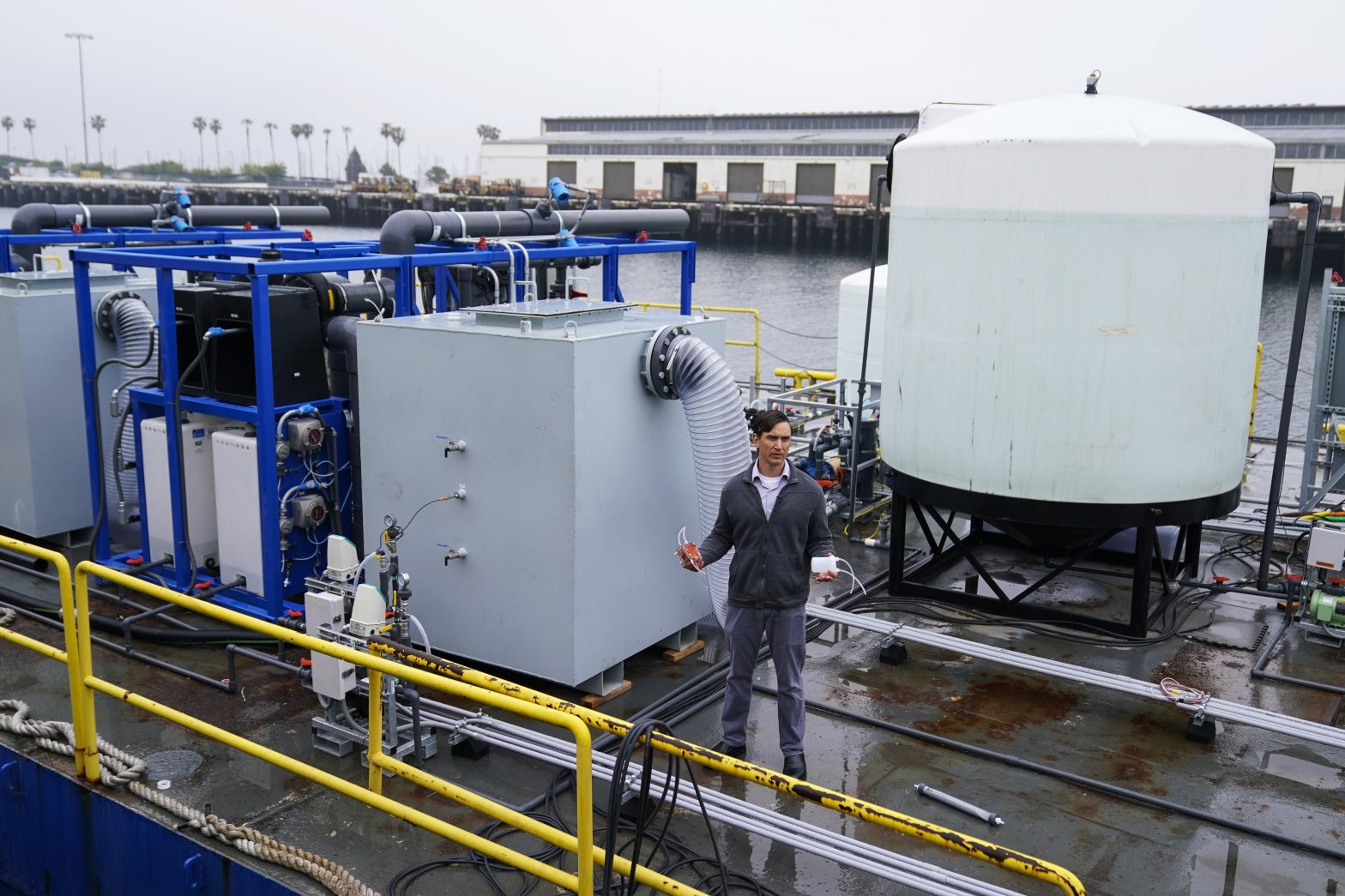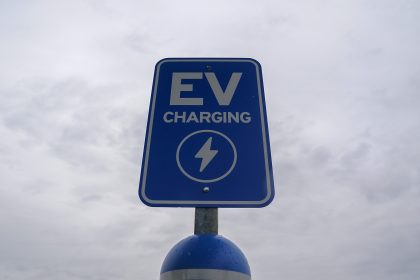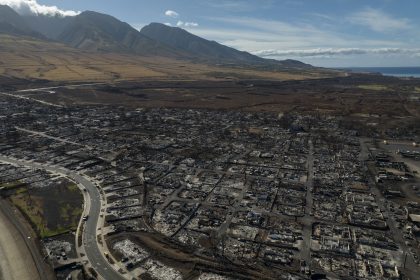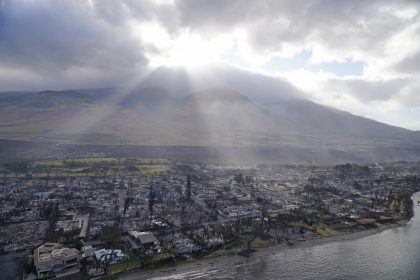California Researchers Attempt Ocean Climate Solution

LONG BEACH, Calif. (AP) — Atop a 100-foot barge tied up at the Port of Los Angeles, engineers have built a kind of floating laboratory to answer a simple question: Is there a way to cleanse seawater of carbon dioxide and then return it to the ocean so it can suck more of the greenhouse gas out of the atmosphere to slow global warming?
Called the lungs of the planet, the ocean, whose plants and currents take in carbon dioxide, has already helped the Earth tremendously by absorbing 30 percent of carbon dioxide emissions since the Industrial Revolution and capturing 90 percent of the excess heat from those emissions. Acting as a giant carbon sink, it has been a crucial buffer in protecting people from even worse effects of early climate change.
Seawater can store 150 times more carbon dioxide per unit volume than air, roughly. But absorbing the greenhouse gas has come at a cost, causing oceans to become more acidic, destroying coral reefs and harming marine species, including impeding shellfish from building their skeletons.
The technology, dubbed SeaChange, developed by the University of California Los Angeles engineering faculty, is meant to seize on the ocean’s natural abilities, said Gaurav Sant, director of UCLA’s Institute of Carbon Management.
The process sends an electrical charge through seawater flowing through tanks on the barge. That then sets off a series of chemical reactions that trap the greenhouse gas into a solid mineral that includes calcium carbonate — the same thing seashells are made of. The seawater is then returned to the ocean and can pull more carbon dioxide out of the air.
Plans are now underway to scale up the idea with another demonstration site starting this month in Singapore. Data collected there and at the Port of Los Angeles will help in the design of larger test plants. Those facilities are expected to be running by 2025 and be able to remove thousands of tons of CO2 per year. If they are successful, the plan is to build commercial facilities to remove millions of tons of carbon annually, Sant said.
But even if the project is able to remove millions of tons, that is still thousands of times less than what will be needed to meaningfully address climate change.
“I’m not saying this won’t work, but the ultimate thing is how much CO2 will it actually draw down on a scale of decades?” said Margaret Leinen, director of Scripps Institution of Oceanography.
Sant doesn’t disagree. Scientists estimate at least 10 billion metric tons of carbon will need to be removed from the air annually beginning in 2050, and the pace will need to continue over the next century.
“That really is the fundamental metric that you’ve got to keep in mind,” he said.
That’s why the success of any of the technologies will rely on “how fast you can build them out,” he added.
According to the UCLA team, at least 1,800 industrial-scale facilities would be needed to capture 10 billion tons of atmospheric carbon dioxide per year, but fewer could still make a dent.
The project is among a host of ideas being explored by scientists who warn that cutting emissions will not be enough to limit global temperature rise to 1.5 degrees Celsius (2.7 degrees Fahrenheit) and avert catastrophic changes to ecosystems.
Much of the attention until recently has been on land-based initiatives such as planting trees or building factories to capture carbon from emitters, but they have limitations including costs and how much land they would cover. So scientists have increasingly turned to help from the ocean, which covers 70 percent of the Earth’s surface.
Among the ideas researchers are looking at is fertilizing the surface of the ocean to cause a proliferation of tiny carbon-absorbing phytoplankton. Another would sprinkle beaches with minerals that could be slowly swept in with the tides or deposited on coast beds to increase seawater’s alkalinity so it can pull more carbon dioxide from the atmosphere.
None of the projects have been tested on a global scale, and there is concern about tampering with the ocean.
Aleck Wang, a marine carbon chemist at Woods Hole Oceanographic Institution, said with the number of ocean-based carbon dioxide removal research projects “booming,” there will likely not be one single solution.
“I think we need all of the methods, at least somewhat, so that we can really get to the target, which is the removal of a huge amount of carbon,” he said.
Researchers from the UCLA Samueli School of Engineering built the demonstration system in two years.
One thing that distinguishes the process is that it produces hydrogen. It also does does not require the dissolved carbon to be buried. Instead the greenhouse gas is converted into a solid that includes materials inherent to oceans, and can be released to settle on the sea floor, Sant said.
To remove a metric ton of carbon dioxide, about 220 metric tons of water needs to flow through the system. That produces 35 kilograms of hydrogen, Sant said.
Sant founded the Los Angeles-based startup Equatic to scale up the project. It would generate revenue from selling the hydrogen, as well as carbon credits that companies, like those in the airline industry, can claim to balance out their pollution, he said. The aim is to remove the carbon at a cost well below $100 a metric ton. The hydrogen would be produced at less than $1 per kilogram, which would be substantially less than the current cost of cleanly-produced hydrogen.
The project has received tens of millions of dollars from supporters including the Chan Zuckerberg Initiative and the U.S. Department of Energy.
Andres Clarens, an engineering professor at the University of Virginia who researches carbon dioxide removal, read Sant’s paper about the project, which has not yet been peer reviewed. He said it is a plus that the process produces hydrogen, but he’s concerned that it would require a lot of energy to make a difference.
He also asks: “What does it mean for people that use the water already for fishing and for you know, other forms of production? What does it mean for those ecosystems?”
Sant said a filtration system bars marine life from being sucked in with the seawater. He called the energy required “minimal.” The system uses about two megawatt hours of energy per ton of carbon dioxide removed but its co-product, hydrogen, produces one megawatt hour of energy. Hydrogen could be used to help power the systems or be sold to be used as a green fuel for industries, Sant said.
“The approach is based on the idea that you want to reduce atmospheric carbon dioxide accumulations,” Sant said.
With any of these efforts, the risks must be weighed carefully to ensure the efforts to limit climate change are truly effective and do not cause greater harm to the planet in the process, scientists say.
Clarens of the University of Virginia said the sea may be where such solutions can be found.
“The ocean is an important sort of untapped place and that’s why I’m very curious to see if they can get this to work,” he said.
























